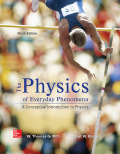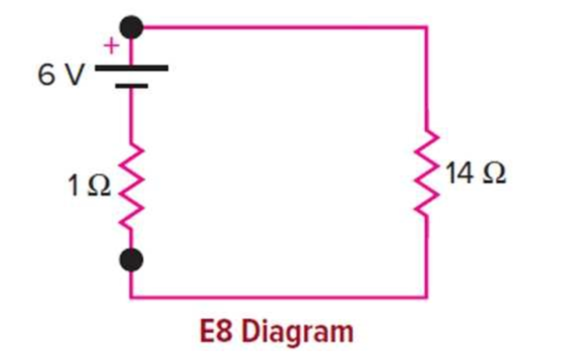
Physics of Everyday Phenomena
9th Edition
ISBN: 9781260048469
Author: Griffith
Publisher: MCG
expand_more
expand_more
format_list_bulleted
Textbook Question
Chapter 13, Problem 8E
In the circuit shown, the 1 Ω resistance is the internal resistance of the battery and can be considered to be in series, as shown, with the battery and the 14 Ω load.
a. What is the current flowing through the 14 Ω resistor?
b. What is the voltage difference across the 14 Ω resistor?

Expert Solution & Answer
Want to see the full answer?
Check out a sample textbook solution
Students have asked these similar questions
What are the expected readings of the ammeter and voltmeter for the circuit in the figure below? (R = 5.60 Ω, ΔV = 6.30 V)
ammeter
I =
simple diagram to illustrate the setup for each law- coulombs law and biot savart law
A circular coil with 100 turns and a radius of 0.05 m is placed in a magnetic field that changes at auniform rate from 0.2 T to 0.8 T in 0.1 seconds. The plane of the coil is perpendicular to the field.• Calculate the induced electric field in the coil.• Calculate the current density in the coil given its conductivity σ.
Chapter 13 Solutions
Physics of Everyday Phenomena
Ch. 13 - Two arrangements of a battery, bulb, and wire are...Ch. 13 - Suppose you have two wires, a battery, and a bulb....Ch. 13 - In a simple battery-and-bulb circuit, is the...Ch. 13 - Are electric current and electric charge the same...Ch. 13 - When an axon is stimulated, a voltage spike or...Ch. 13 - Does the signal in an axon travel at the same...Ch. 13 - Consider the circuit shown, where the wires are...Ch. 13 - Consider the circuit shown. Could we increase the...Ch. 13 - Two circuit diagrams are shown. Which one, if...Ch. 13 - Suppose we use an uncoated metal clamp to hold the...
Ch. 13 - Consider the two signs shown, which are located in...Ch. 13 - If we decrease the potential difference across a...Ch. 13 - Prob. 13CQCh. 13 - When a battery is being used in a circuit, will...Ch. 13 - Two resistors are connected in series with a...Ch. 13 - In the circuit shown below. R1, R2,. and R3 are...Ch. 13 - In the circuit shown in question 16, which of the...Ch. 13 - If we disconnect R2, from the rest of the circuit...Ch. 13 - When current passes through a series combination...Ch. 13 - In the circuit shown, the circle with a V in it...Ch. 13 - In the circuit shown, the circle with an A in it...Ch. 13 - Which will normally have the larger resistance, a...Ch. 13 - Is electric energy the same as electric power?...Ch. 13 - If the current through a certain resistance is...Ch. 13 - Prob. 25CQCh. 13 - What energy source increases the potential energy...Ch. 13 - Prob. 27CQCh. 13 - Prob. 28CQCh. 13 - Prob. 29CQCh. 13 - Prob. 30CQCh. 13 - Prob. 31CQCh. 13 - Prob. 32CQCh. 13 - Why does a bimetallic strip bend when the...Ch. 13 - A charge of 28 C passes at a steady rate through a...Ch. 13 - A current of 4.5 A flows through a battery for 3...Ch. 13 - Prob. 3ECh. 13 - A current of 1.5 A is flowing through a resistance...Ch. 13 - A current of 0.522 A flows through a resistor with...Ch. 13 - Four 22 resistors are connected in series to an...Ch. 13 - A 47 resistor and a 28 resistor are connected in...Ch. 13 - In the circuit shown, the 1 resistance is the...Ch. 13 - Three resistors are connected to a 12-V battery as...Ch. 13 - Two resistors, each having a resistance of 40 ....Ch. 13 - Prob. 11ECh. 13 - Three identical resistances, each 30 , are...Ch. 13 - A 9-V battery in a simple circuit produces a...Ch. 13 - A 80 resistor has a voltage difference of 12 V...Ch. 13 - A 75-W light bulb operates on an effective ac...Ch. 13 - A toaster draws a current of 9.0 A when it is...Ch. 13 - A clothes dryer uses 6600 W of power when...Ch. 13 - In the circuit shown, the internal resistance of...Ch. 13 - Three 36 lightbulbs are connected in parallel to...Ch. 13 - In the circuit shown, the 8-V battery is opposing...Ch. 13 - In the combination of 12 resistors shown in the...Ch. 13 - A 850-W toaster, a 1200-W waffle iron, and a...
Knowledge Booster
Learn more about
Need a deep-dive on the concept behind this application? Look no further. Learn more about this topic, physics and related others by exploring similar questions and additional content below.Similar questions
- An L-C circuit has an inductance of 0.410 H and a capacitance of 0.250 nF . During the current oscillations, the maximum current in the inductor is 1.80 A . What is the maximum energy Emax stored in the capacitor at any time during the current oscillations? How many times per second does the capacitor contain the amount of energy found in part A? Please show all steps.arrow_forwardA long, straight wire carries a current of 10 A along what we’ll define to the be x-axis. A square loopin the x-y plane with side length 0.1 m is placed near the wire such that its closest side is parallel tothe wire and 0.05 m away.• Calculate the magnetic flux through the loop using Ampere’s law.arrow_forwardDescribe the motion of a charged particle entering a uniform magnetic field at an angle to the fieldlines. Include a diagram showing the velocity vector, magnetic field lines, and the path of the particle.arrow_forward
- Discuss the differences between the Biot-Savart law and Coulomb’s law in terms of their applicationsand the physical quantities they describe.arrow_forwardExplain why Ampere’s law can be used to find the magnetic field inside a solenoid but not outside.arrow_forward3. An Atwood machine consists of two masses, mA and m B, which are connected by an inelastic cord of negligible mass that passes over a pulley. If the pulley has radius RO and moment of inertia I about its axle, determine the acceleration of the masses mA and m B, and compare to the situation where the moment of inertia of the pulley is ignored. Ignore friction at the axle O. Use angular momentum and torque in this solutionarrow_forward
- A 0.850-m-long metal bar is pulled to the right at a steady 5.0 m/s perpendicular to a uniform, 0.650-T magnetic field. The bar rides on parallel metal rails connected through a 25-Ω, resistor (Figure 1), so the apparatus makes a complete circuit. Ignore the resistance of the bar and the rails. Please explain how to find the direction of the induced current.arrow_forwardFor each of the actions depicted, determine the direction (right, left, or zero) of the current induced to flow through the resistor in the circuit containing the secondary coil. The coils are wrapped around a plastic core. Immediately after the switch is closed, as shown in the figure, (Figure 1) in which direction does the current flow through the resistor? If the switch is then opened, as shown in the figure, in which direction does the current flow through the resistor? I have the answers to the question, but would like to understand the logic behind the answers. Please show steps.arrow_forwardWhen violet light of wavelength 415 nm falls on a single slit, it creates a central diffraction peak that is 8.60 cm wide on a screen that is 2.80 m away. Part A How wide is the slit? ΟΙ ΑΣΦ ? D= 2.7.10-8 Submit Previous Answers Request Answer × Incorrect; Try Again; 8 attempts remaining marrow_forward
- Two complex values are z1=8 + 8i, z2=15 + 7 i. z1∗ and z2∗ are the complex conjugate values. Any complex value can be expessed in the form of a+bi=reiθ. Find θ for (z1-z∗2)/z1+z2∗. Find r and θ for (z1−z2∗)z1z2∗ Please show all stepsarrow_forwardCalculate the center of mass of the hollow cone shown below. Clearly specify the origin and the coordinate system you are using. Z r Y h Xarrow_forward12. If all three collisions in the figure below are totally inelastic, which will cause more damage? (think about which collision has a larger amount of kinetic energy dissipated/lost to the environment? I m II III A. I B. II C. III m m v brick wall ע ע 0.5v 2v 0.5m D. I and II E. II and III F. I and III G. I, II and III (all of them) 2marrow_forward
arrow_back_ios
SEE MORE QUESTIONS
arrow_forward_ios
Recommended textbooks for you
 Principles of Physics: A Calculus-Based TextPhysicsISBN:9781133104261Author:Raymond A. Serway, John W. JewettPublisher:Cengage Learning
Principles of Physics: A Calculus-Based TextPhysicsISBN:9781133104261Author:Raymond A. Serway, John W. JewettPublisher:Cengage Learning College PhysicsPhysicsISBN:9781938168000Author:Paul Peter Urone, Roger HinrichsPublisher:OpenStax College
College PhysicsPhysicsISBN:9781938168000Author:Paul Peter Urone, Roger HinrichsPublisher:OpenStax College Physics for Scientists and Engineers, Technology ...PhysicsISBN:9781305116399Author:Raymond A. Serway, John W. JewettPublisher:Cengage Learning
Physics for Scientists and Engineers, Technology ...PhysicsISBN:9781305116399Author:Raymond A. Serway, John W. JewettPublisher:Cengage Learning Physics for Scientists and Engineers with Modern ...PhysicsISBN:9781337553292Author:Raymond A. Serway, John W. JewettPublisher:Cengage Learning
Physics for Scientists and Engineers with Modern ...PhysicsISBN:9781337553292Author:Raymond A. Serway, John W. JewettPublisher:Cengage Learning Physics for Scientists and EngineersPhysicsISBN:9781337553278Author:Raymond A. Serway, John W. JewettPublisher:Cengage Learning
Physics for Scientists and EngineersPhysicsISBN:9781337553278Author:Raymond A. Serway, John W. JewettPublisher:Cengage Learning Physics for Scientists and Engineers: Foundations...PhysicsISBN:9781133939146Author:Katz, Debora M.Publisher:Cengage Learning
Physics for Scientists and Engineers: Foundations...PhysicsISBN:9781133939146Author:Katz, Debora M.Publisher:Cengage Learning

Principles of Physics: A Calculus-Based Text
Physics
ISBN:9781133104261
Author:Raymond A. Serway, John W. Jewett
Publisher:Cengage Learning

College Physics
Physics
ISBN:9781938168000
Author:Paul Peter Urone, Roger Hinrichs
Publisher:OpenStax College

Physics for Scientists and Engineers, Technology ...
Physics
ISBN:9781305116399
Author:Raymond A. Serway, John W. Jewett
Publisher:Cengage Learning

Physics for Scientists and Engineers with Modern ...
Physics
ISBN:9781337553292
Author:Raymond A. Serway, John W. Jewett
Publisher:Cengage Learning

Physics for Scientists and Engineers
Physics
ISBN:9781337553278
Author:Raymond A. Serway, John W. Jewett
Publisher:Cengage Learning

Physics for Scientists and Engineers: Foundations...
Physics
ISBN:9781133939146
Author:Katz, Debora M.
Publisher:Cengage Learning
DC Series circuits explained - The basics working principle; Author: The Engineering Mindset;https://www.youtube.com/watch?v=VV6tZ3Aqfuc;License: Standard YouTube License, CC-BY